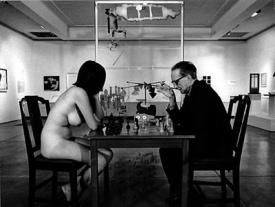I first became aware of Nancy Sinatra when her song “These Boots Were Made For Walkin'” climbed up the charts in the 60s. The song was written by Lee Hazelwood, and I had the sense that it was a kind of novelty rather than being representative of a body of work. The song was released in February of 1966, and featured a back-up band known as the “wrecking crew“— they were made up of first call session players in Los Angeles.
Ms. Sinatra caught my attention again recently with her editorial in the New York Times regarding the inequity of payments for songs played on the radio. Composers and publishers receive payment each time a song is played, but performers get nothing. The presumption is that the performing artists receive promotion when their songs are played and that serves as their compensation. Ms. Sinatra notes that the practice of mentioning the title and artist of a song just played is no longer common practice. And she reveals that ten years ago Clear Channel was asking $24k per title, to mention a song’s meta-data. A radio mention is meant to serve as a kind of link to a commerce service point.
Just as the telecom industry is coming to terms with the fact that voice is indistinguishable from any other kind of bits traveling through the series of tubes, the radio/music business is learning that there’s no such thing as a ‘sound only’ Network. Recorded music needs an extensible interface, sound is only one of the channels. Video, text, images and commerce are some of the channels that need to be included in the digital bundle. When you ‘right-click’ on a tune, what options will you see? If you look closely, you can see the distinction between the player and the thing played is beginning to disappear.
The music industry has responded to this opening with the CMX file format. As currently defined the format will allow playback and viewing of multiple media types, transactional capabilities have not been mentioned. Apple has rejected CMX in favor of its own format called Cocktail. Early rumors are that the Cocktail format will be playable on a new generation iTunes player, although it may also work as standalone software with an incorporated runtime.
Rolling up the various media files associated with a music release into a single new format will create a new container that can be sold to the music buying masses. If all goes according the plans of the record labels, the public will be thrilled to restock their music libraries with new containers of the same music. After all, the public has done it a number of times before. Presumably, the new format will also feature stronger DRM as an attempt to re-establish the old sales model. The most intriguing part of Apple’s Cocktail format is the rumored integration of a social media layer into iTunes.
Some think the record business was destroyed by the MP3 file format. Because an MP3 is simple to digitally copy, the theory is that sales suffered as the listening audience simply distributed free copies of music over the Network. While there’s a grain of truth to this, ventures like the iTunes music store could not have been successful if it were the dominant behavior pattern. The real threat to the music industry was the return of the single and the rise of the playlist.
The record album became the standard unit of sale for music some time after the Beatles managed to fill their offerings with hits from the first track to the last. Once the public stopped buying singles and started buying albums, the goldrush was on for the record companies. The album also served as a kind of filter, bands that couldn’t sustain a level of quality over an entire record didn’t last long. The album became a canvas, a programmed static playlist of music that eventually lead, for better or worse, to the concept album.
The high cost of recording music combined with the album format resulted in a batch production mode for music—also known as the recording session. Batch mode production is closely related to the kind of production done in factories. A special environment is created, set away from ordinary life. Real life is what you return to when you’ve finished your shift working in the factory. With the cost of recorded music production plummeting, the batch mode becomes less and less necessary. Real-time production occurs in-line with real life, the process might look more like the basement of Big Pink instead of the specialized and fully-equipped recording studio.
A bundle of static files wrapped up in a new format is an attempt to get some additional mileage out of the album format. There’s a sense in which this is a duplication of the shrink-wrapped software model. The music industry should look to the recent strategic shifts made by the king of shrink-wrapped software: Microsoft. Microsoft has shifted to a software + services model that includes the full interoperability and the integration of public social media streams. Some of their product will be free, some ad supported and others will be fully paid. And just as the batch mode of software production has been deprecated in favor of real-time, in-line code updates over the Network, music (and all digital media) will eventually move toward this new model.
The battle that Nancy Sinatra is waging on behalf of the performer will not be won in the landscape of radio. That playing field is receding, becoming a small piece of the puzzle, rather than whole ballgame. The new canvas for the digital performer and recording artist is starting to emerge and the examples provided by Microsoft, Google and Apple will lead the way.
Comments closed

